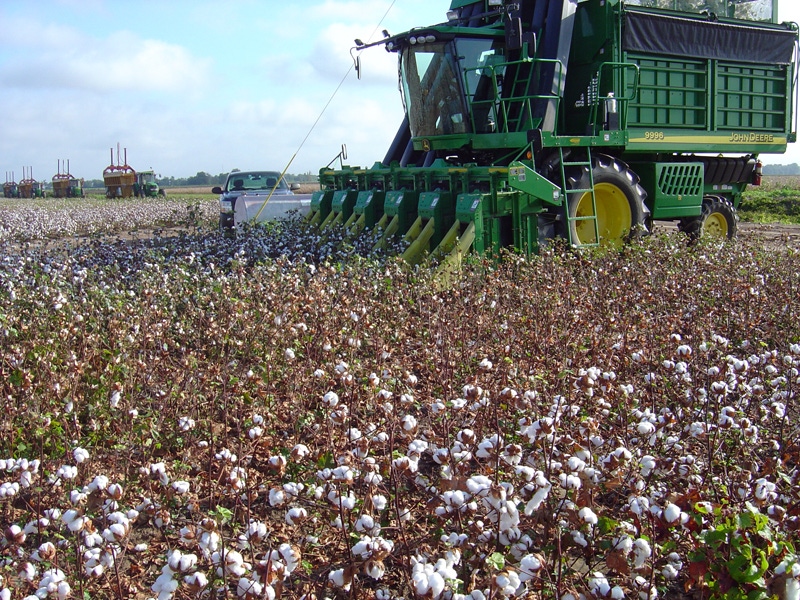
USDA raised world ending stocks to an extremely bearish 66.1 million bales in April, which immediately sent December 2012 cotton futures lower.USDA increased India’s 2011 beginning stocks by 3.25 million bales and ending stocks by 1.6 million bales based on analysis of historical data.USDA also increased China’s estimated stocks by 3 million bales to 23.1 million bales. China’s forecast ending stocks now account for 35 percent of world stocks.

A huge increase in estimated world ending stocks, based on cotton discovered in inventory in India, jolted the market in early April.
The new supplies reported in USDA’s April 10 World Agricultural Supply and Demand Estimates, raised world ending stocks to an extremely bearish 66.1 million bales and immediately sent December 2012 cotton futures lower that day.
“We were thrown a bit of curveball in those numbers,” said O.A. Cleveland, professor emeritus, Mississippi State University, speaking at the Ag Market Network’s April conference call. “The huge increase in ending stocks put the bears back in control of the market.”
USDA increased India’s 2011 beginning stocks by 3.25 million bales and ending stocks by 1.6 million bales based on analysis of historical data which indicated that stocks were significantly higher than previously estimated. (see http://www.fas.usda.gov/psdonline/circulars/cotton.pdf for further details).
USDA also increased China’s estimated stocks by 3 million bales to 23.1 million bales. China’s forecast ending stocks now account for 35 percent of world stocks.
“These were very large changes in very important cotton producing and consuming countries,” Cleveland said.
Cleveland noted that USDA also raised China’s imports by 2 million bales, putting China’s total import estimate at 20.5 million bales. USDA also lowered China’s use by 1 million bales.
Brazil’s projected cotton exports are also 100,000 bales higher, noted Cleveland, while its ending stocks were lowered 100,000 bales to 3.4 million bales.
“This was just a massive increase in world ending stocks and stocks-to-use ratio,” said John Robinson, Extension economist at Texas A&M University. “Sixty percent of the world’s needs for next year are already sitting in warehouses. Other times when the world stocks-to-use was at this level, the A-Index was at 55 cents. So we’re still at historically high and abnormal price levels given the surplus inventory.”
Much depends on how you view those stocks, noted Robinson. “Thirty-five percent of the stocks are in China, and much of that is in China’s reserves. Do you view that cotton as available? It’s at least a big uncertainty. I don’t think it’s good because it’s in the hands of policy and bureaucrats as opposed to being market-driven.”
Meanwhile, lower estimated U.S. cotton production and an increase in exports combined to lower 2011-12 U.S. ending stocks to 3.4 million bales.
“The numbers on the U.S. side appear bullish, but the USDA report is very bearish in total for the world, with USDA finding so much in inventory,” Cleveland said. “It jerked the rug out from under us.”
Cleveland also noted that Mid-South and Southeast cotton producers have been shifting to alternative crops since USDA’s March 30 Prospective Plantings report. “By the time we get everything planted, U.S. cotton acreage will probably fall to somewhere around 12.8 million acres, which 400,000 bales below USDA’s March 30 projection.”
Mike Stevens, cotton analysts from Mandeville, La., believes December cotton’s upside “is going to be limited to the low 90s. Given the fundamentals that we know, I don’t see December getting back to 95 cents. On the downside, if 87 cents doesn’t hold it, you’re looking at 80 cents to 83 cents pretty quickly.”
“I think December may have a little life left in it once we get our true acreage out there,” Cleveland said.
Chinese farmers could also reduce cotton acreage, noted Cleveland. “Their grain and oilseed prices are even higher than ours, which is telling them to back out of cotton if they have an alternative.”
On whether high corn and soybean prices could bolster cotton prices, Stevens noted, “The cotton market is telling you that there is plenty of cotton out there in the world, and it’s not particularly interested in buying acres this year. The world seems to be awash with cotton.”
Robinson sees December 2012 cotton futures at 75 cents on the downside and 93 cents on the upside.
The analysts noted that while cotton supplies are burdensome, most of the cotton supplies in the world are being held in a handful of countries, one of which, India, hasn’t proven to be a very good trading partner.
About the Author(s)
You May Also Like





